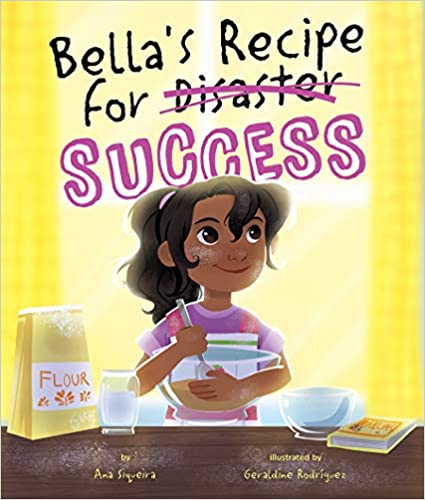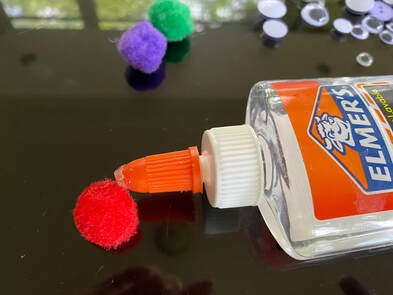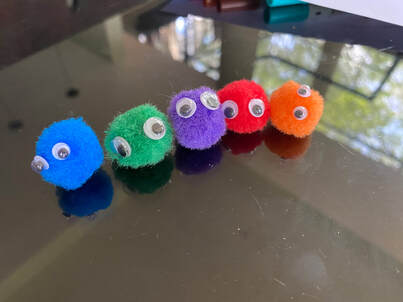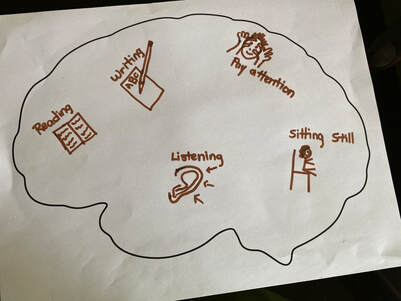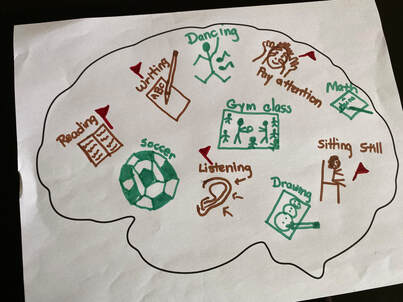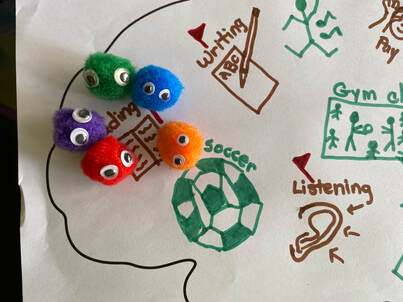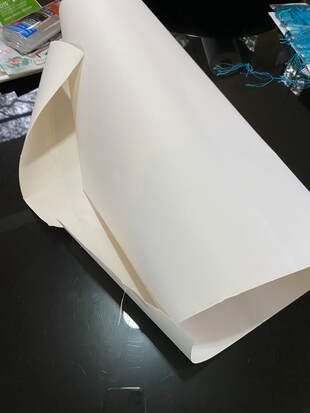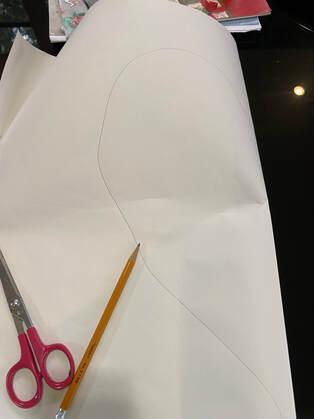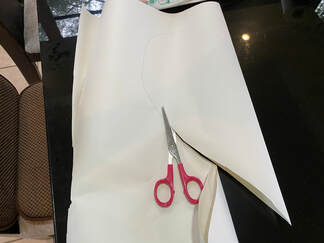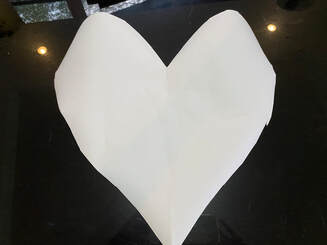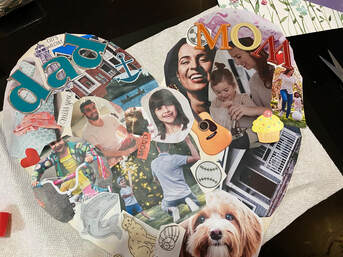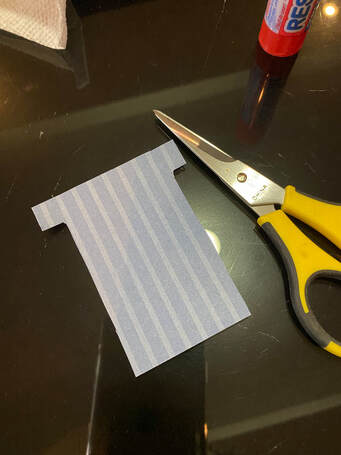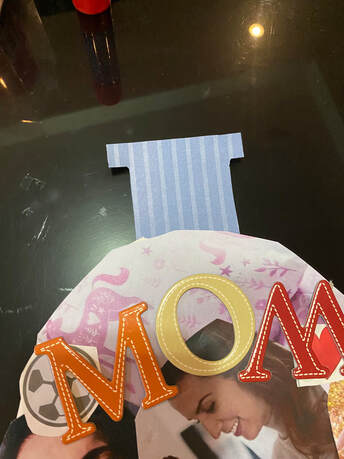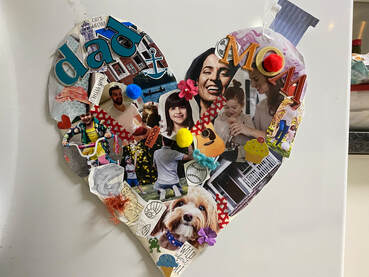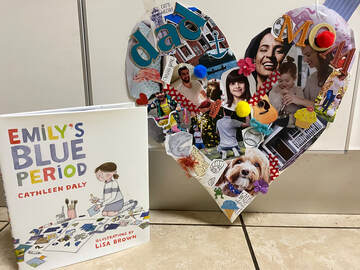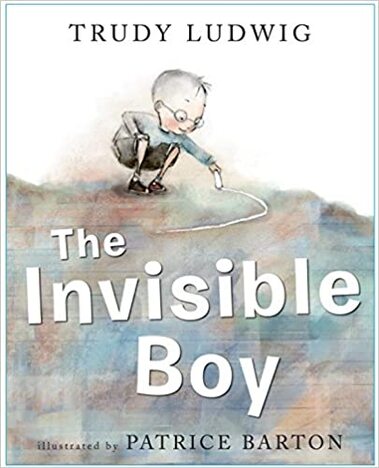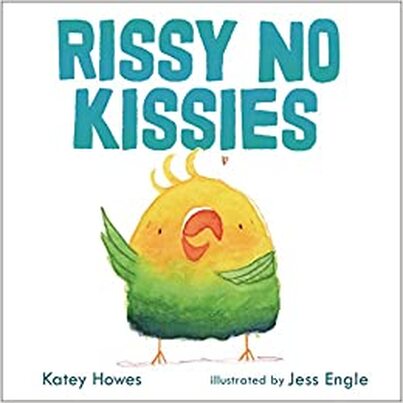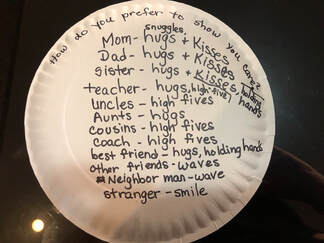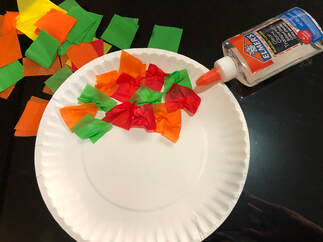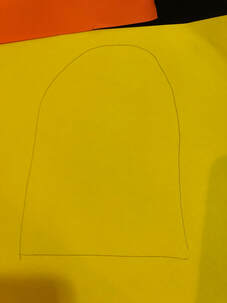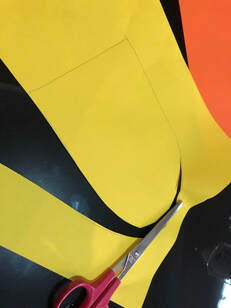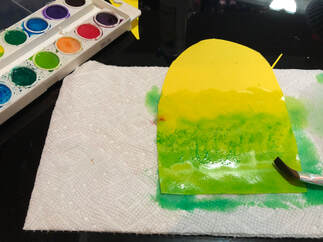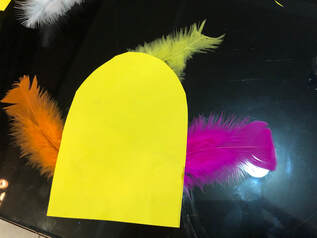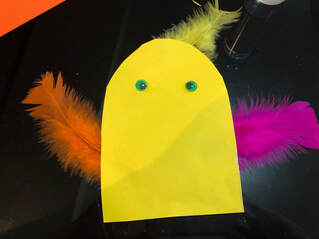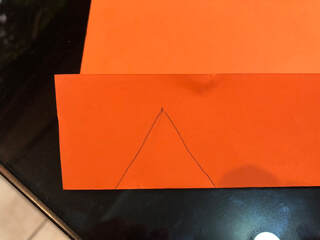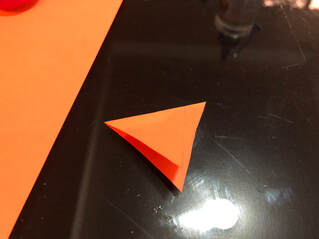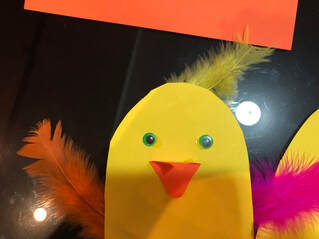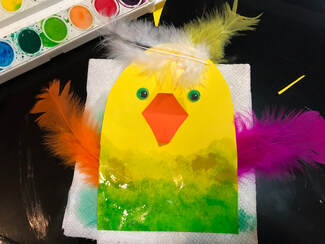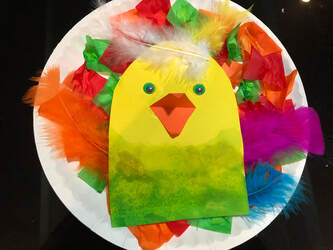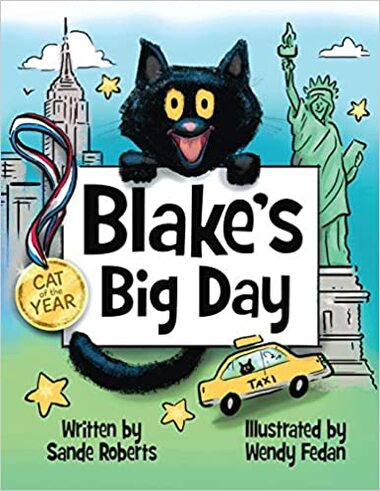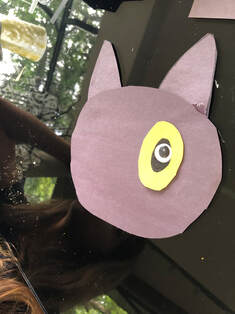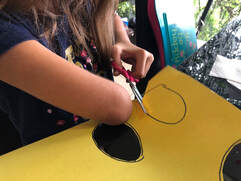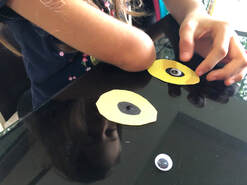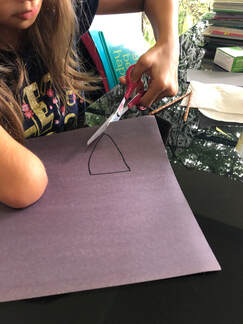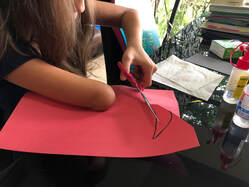A Book Review of Bella's Recipe for Success
Bella, the main character, upon witnessing the special skills of her siblings, searches for her own strengths. However, after half-hearted attempts at gymnastics and piano-her sibling's skills-she comes up empty. Then she decides that maybe baking is an area in which she can excel, like her abuela (grandmother). After much frustration and discouragement with her baking attempts, she persists. In fact, she tries so many times that I'm pretty sure she ran out of vanilla in the process! And with a nice touch by the illustrator, she made a major flour mess along the way (that I can totally relate to!). Eventually, Bella gets the recipe just right and all of her practice is rewarded with delicious cookies (oops, until she trips on the cat and they go flying across the room!). Through this story, Ms. Siqueira highlights the universal lapses of self-confidence that touches all of us from time to time. When we see others' successes, we may become discouraged, or even a little envious. Sometimes it seems that a certain skill comes easy for another person. We don't see the grit and hard work that the person plowed through to get to that skill level. But, if you've lived long enough, you know that nothing in this world comes easily. Everything takes hard work and lots of practice, which is the message of the book. Although, let's face it, even though EVERYTHING takes practice, we all do have strengths and weaknesses (or challenges). These are based on heredity, innate neurological functioning and/or early learning experiences. Certain skills may come a little easier for us than other skills. To borrow wisdom from abuela in the book, "We're all good at different things." As a side note, I especially love the value placed on the wisdom and experience of the abuela in the story, which in our culture of technology has become undervalued. While reading about Bella, I thought of the many kids I have encountered in my practice. Many of whom have experienced more than their fair share of defeat in life. That defeat may be due to their family circumstances, physical disabilities, mental health challenges or learning disabilities. Therefore, the themes raised in this book may become more pronounced for them, as their self-esteem has suffered. The common response of many of these children when confronted with a challenge often is "I can't." Therefore, this book would be especially helpful in these circumstances. Often kids with learning disabilities, for example, compare themselves to other students in their class and feel inadequate. When working with these kids, I encourage them to explore their own strengths instead of dwelling on their challenges. For example, maybe reading is difficult for you, but you have a real science mind. Maybe you struggle with math, but you are a great soccer player. Maybe you don't walk well due to your disability, but you are a reading whiz. Maybe you struggle with paying attention, but you have amazing art skills. Maybe you lose your temper easily, but you have a great sense of humor. A general idea on how I present this concept to kids is as follows: Some parts of our brains (challenges) don't work as well as other parts (strengths). So, those challenge parts have to depend on other parts of the brain to kick in and help. I refer to those helpers in the brain as "brain buddies." In order to get the "brain buddies" to work together, it takes much extra work and time, and can be frustrating. But, many skills that are hard for us are very important. So, we can't let the "brain buddies" give up. When we practice, we cheer on the "brain buddies!" However, other parts of our brain, our strengths, work well and don't have to rely on the 'brain buddies' to help out. Those things still require much practice, but maybe aren't as frustrating to master. Displayed below, is a project using the above concept. This works well with kids that struggle with defeat. It is a perfect accompaniment to this book. Bella's Recipe for Success is about hope. Hope in our abiities to accomplish things and confidence in our abilities to contribute to the world in some way. Our mental health depends on this! If you'd like to try your own hand at baking, Bella's special ethnic recipe is included at the back of the book! To purchase this book and to check out upcoming books by the author, Ana Siqueira, click here. An Activity Idea for Bella's Recipe for SuccessFirst of all, of course make the polvorones from the recipe in the book. You can snack on those while doing the project below! Remember, if you mess them up the first time, try, try again! In this month's project, we are going to talk about our own challenges and strengths, and draw them in our brain. Then, we are going to make warm and fuzzy "brain buddies" to help out with our challenges when needed. The "brain buddies" represent other parts of the brain that we need to access to help the part of the brain that is struggling. This is especially helpful for kids with learning problems. This project helps demonstrate why learning some skills is harder and takes longer to master than others. And, of course, to normalize the fact that we all have our challenges and strengths. Enjoy!
4 Comments
Great news on Psyched Writer Blog this month! I have added categories linked to the topics of the book reviews/activity ideas. So, from now going forward, it will be much easier to find the topic you are looking for. I'm hoping this addition will make this blog experience much more user-friendly. The categories are listed on the right side of the post. Just click the category of interest and all of the book reviews/activities related to that topic will pop up. Check it out! A Book Review of Emily's Blue Period
For example, if you are looking for a book on anxiety, you go to the "Anxiety" section and, VOILA, there are all of their books that address this topic in one spot! The books are mostly fiction and represent all age levels from adults to young children. Definitely, a bibliotherapist's dream! If you live in or visit the area, I definitely recommend checking it out in person. If not, their books are available for purchase on-line too! Check out their website here. Emily's Blue Period is one of the books I picked up at Oh Hello Again in September! I knew going into the store that my blog was lacking books on divorce. So, when I arrived into the store, I went to the section on "Divorce" and, VOILA, this book was calling my name! Emily's Blue Period is a picture book/early chapter book hybrid. It's divided into a few chapters and the length is a bit longer than a traditional picture book. However, it is full of beautiful illustrations. I would use this book for a wider range of children, specifically 4 - 10 year olds. The younger readers may need to read it in more than one sitting, depending on their attention span. The author, Cathleen Daly, does a fabulous job integrating a love of art, facts about a famous artist and the experience of separation/divorce into one story. The art focus in the story, in addition to teaching kids a bit about art history, lightens up the intense feelings portrayed in the book. The main character, Emily, wants to be an artist when she grows up. She is learning about Pablo Picasso in school and makes efforts to emulate him. After Emily's father moves out of their house into an apartment, Emily uses her knowledge of Picasso to help navigate her experience. She compares Picasso's art of mixing things up to her family being mixed up. When Emily learns about Picasso's blue period, in which he was very sad and only painted in shades of blue, she relates and decides she is in her "blue period" also. During this time, her sadness comes through clearly in the book, as she refuses to participate in art class unless she can use the color blue. The book also brings in the strong emotions of Emily's brother, Jack, as he responds to the family situation with anger. The climax of the story comes when Emily learns about collage in art class. The teacher assigns the class a project to make a collage of their house. This is sad and confusing for Emily as she does not know which house to call her own. With the help of her family, she learns that "Home is where the heart is," and eventually comes up with an idea. Emily creates a collage in a heart shape and integrates special things from her mom and dad's house on her one heart. She calls it the home of her heart. This activity is very therapeutic for Emily and marks the end of her "blue period." The illustrations by Lisa Brown are detailed and in muted colors which fit the mood of the story. She uses a dull shade of blue throughout much of the book to accentuate the sadness that Emily is experiencing. I highly recommend this book for children who are navigating through separation and divorce of their parents. The collage activity from the story is such a great therapeutic activity, that this is the activity I'm going to recommend this month. Check out the author's website and explore other books by this author here. An Activity Idea of Emily's Blue PeriodThis month we are going to create the same project as Emily in the book. It is an amazingly therapeutic idea for children of divorce, so I want to highlight it. This project is likely going to take more than one session. Materials Needed: -large paper roll -pencil -scissors -glue stick and strong glue -crayons or markers -old magazines -photos of parents, siblings, houses, etc. -Collected reminder items from each home that child would like to include -cut out computer images if needed -heart stickers (optional)
A Book Review of The Invisible Boy
The Invisible Boy is a book I treasure as it is one after my own heart. I was one of those quiet children and I would venture to guess, the author, Trudy Ludwig, was one or knew one intimately. She shows incredible insight into the realities of an introverted child throughout this book. I truly appreciate this perspective as there are few people who recognize the inner workings of the quiet child. The majority of books on the subject focus on changing the quiet child to become more outgoing. This reflects the presumption in our society that being quiet is somehow less desirable than being outgoing. This book takes a refreshing spin and celebrates Brian for who he really is and not who society wants him to be. As important as it is for us to accept and celebrate cultural differences, it is equally important to accept and celebrate personality differences. The needs of quiet kids often get overlooked as they do not bring attention to themselves. They may not want to be the center of attention, but they still want to feel included. They may not want public recognition, but they still want to be recognized. They may not be the life of the party, but they want to be invited. We all can't be actors on the stage. Without the people in the background making the props, working the lights or making the costumes, the show will not go on. The struggles Brian encounters throughout the book are typical classroom situations that are often dreaded moments for the quiet child. For example, -Being told to team up with a partner for a project, -Classmates picking teams for sports -Others talking about things in which the quiet child wasn't included -Lunchtime Each one of these common classroom situations remind quiet kids of their standing in the classroom-INVISIBLE. Brian's experience to these awkward moments is described insightfully in the book as follows: "Brian looks at the floor, wishing he could draw a hole right there to swallow him up." I am certain that is a statement in which most quiet kids can relate! Wouldn't it be nice to provide a classroom environment where quiet kids didn't have to feel that way throughout the day? Brian's unique strengths are portrayed in the book. Similar to many quiet kids, Brian is sensitive to the feelings of others, and observes and notices many things that his louder peers may not. Brian's life in the classroom improves when he overhears the new boy in class, Justin, being teased and writes a special note to him. This is Brian's unique way of showing kindness in a quiet way that others may not notice. However, it only takes the kindness of one person to lead others to be kind. After receiving the note, Justin is then kind to Brian and includes him with another friend. After seeing Justin being kind to Brian, the other friend includes Brian too. And this kindness chain will spread to others. By the end of the story, Brian is recognized for his artistic talent in a small group situation, which makes him feel special and included. One of my favorite features in this book, is the creativity of the illustrator, Patrice Barton. The illustrations are large and colorful and grab the reader's attention. Brian's artistic talents are clearly displayed with many interesting and fun children's drawing. The special gem in this book is that Brian is in black and white at the beginning of the story, and the rest of the illustrations are in color. As the book progresses, and Brian starts to feel more included and comfortable, more color is added to his character. By the end of the story, Brian is drawn in full color. This is such a clever visual detail that adds much intensity to the story. Let's not forget, the quiet kids need oil too. Make an effort to notice them and accentuate their strengths. The world will be better, and more colorful, for it. To purchase this book, and check out others by this author, click HERE. An Activity Idea for The Invisible Boy Materials Needed: -Paper -Pencil -Crayons -Envelope Directions:
Ask the child if there was a time they felt invisible like Brian. If so, have the child draw a picture of what happened and discuss how that felt when it happened. Discuss their personality and Brian's personality. How are they the same? How are they different? Have the child think of someone at school, in their neighborhood or family, that may feel invisible. Or someone they witnessed being teased or bullied. List some ideas they can do to make them feel included and valued. Using Brian's idea in the book, have the child write a note to this person they are thinking of. What can they say to make this child feel included or special? Have the child draw a picture on the note to show the child that they are noticed. Then ask, How do you think the child will feel when they get your note? How will you feel about giving them the note? A Book Review of Rissy No Kissies
Rissy No Kissies is an important book for many reasons. It addresses body autonomy, consent, boundaries, sexual abuse prevention and sensory issues. That is a lot of value to pack into a picture book. So, I am definitely a fan! The author, Katey Howes, did a great job presenting these concepts in an engaging way that young children can understand. The colorful watercolor illustrations by Jess Engle are adorable and help to lighten up this heavy subject. This book is as important for adult readers as it is for kids, as we are responsible for allowing kids to have autonomy over their bodies. Even if Uncle Joe doesn't like it, we need to give the message to our kids that they have the right to say "No" to unwanted physical touching of any kind. Kids need to have the power to make decisions about their bodies and practice this skill to build confidence for high school, college and later years when consent becomes an even bigger issue. The reason the topic of body autonomy and consent are so important to kids is seen in the statistics. According to the nation's largest anti-sexual violence organization (RAINN), in the United States: *1 in 9 girls and 1 in 53 boys under 18 years of age experience sexual abuse or assault at the hands of an adult. *Females ages 16 - 19 are four times more likely to be victims of rape, attempted rape or sexual assault. *Every 68 seconds an American is sexually assaulted. *Child sexual abuse perpetrators are: *59% acquaintances *34% family members *7% strangers The effects of sexual abuse and assault severely affect the victim's mental health, whether the victim is a child or an adult. Therefore, it is imperative that we do a better job at prevention. Learning concepts like these at a young age, will go a long way to prevention. it is crucial for adults to respect the preferences of kids when it comes to touch. Unfortunately, all adults are not going to do this, so this is when the caretaker needs to step in and validate the child's preferences. Saying "No" to an unwanted hug now can translate into having the confidence to say "No" later to an unwanted sexual encounter. It is especially important to practice these skills when there is a power deference. When someone has power over you, like an adult to a child, it is much more difficult to say "No." Kids have been taught repeatedly to listen to adults, respect their elders, etc. Unfortunately there are adults that take advantage of this power deference and this is a huge factor in the sexual abuse of children. This is also true for sexual assault in adults. The perpetrator often has power over the victim, whether it be due to age, role (parent, teacher, priest, boss, coach, etc.), physical size or social status. We need to practice saying "No" to those who have power over us when it comes to our bodies. The more practice kids get, the easier it will become later. It is the child's choice how to show love and caring to others and there are many options. Rissy is more comfortable with the options of giving feather fives, nuzzles, singing songs, holding wings, giving cards, hugs, handshakes, and waves. Also this is not universal. She may be comfortable hugging her parents, but not comfortable hugging Uncle Joe. She may prefer to give teachers and peers high fives, rather than snuggle with them. Comfort level depends on the relationship. Children have good instincts on who is not safe and as adults, we need to help children get to the point of trusting their own instincts. Another huge factor in learning about consent as a young child is learning the concept of obtaining permission before touching another person. Learning to respect another's body and not feeling entitled to do what you want to someone else without their permission is crucial. Whether it's a hug from Uncle Joe to a 5 year old, or a sexual encounter with a college classmate. If we learn from a young age that all of these things require permission, this will become the norm and sexual assaults will decrease. Asking a peer if they can give them a hug before doing it, and learning to respect their response, can translate to asking a peer later for a sexual encounter and respecting their "No." Additionally, sensory issues are very prevalent and to some people certain kinds of physical touch are uncomfortable. It is important that this is normalized and children or adults with sensory issues aren't made to feel "weird" for refusing certain kinds of touch. The message in this book is actually quite simple. Let's just respect one another and teach this from a young age. At the end of the book, the author has added a helpful note for kids and caregivers. If you're interested in more information about sexual abuse and assault, including a hot line number, you can learn more here. If you'd like to purchase this book and check out others by this author, click here. I have included an activity below to further explore the concepts in this book with kids. An Activity Idea for Rissy No Kissies The most important activity is to practice and model with kids the concept of asking others before touching them. Equally important is to have them practice using their voice to say if a certain touch is uncomfortable to them. Role playing is a helpful activity to practice these skills. Then, have fun with the following craft activity! Materials Needed: -white paper plate -black marker -tissue paper cut into squares and scrunched -glue -yellow construction paper or cardstock -orange construction paper -watercolor paints or crayons -paint brush and cup of water -craft feathers -googly eyes (optional)
A Book Review of Blake's Big Day
Blake, the other character in the book, is Glen's cat. Blake is a smart and caring cat. Blake was born into a situation where he was not well cared for or fed properly. The place where he lived was dirty and full of other cats that were also uncared for. Glen adopted Blake after he was rescued from this bad situation and brought to a shelter. Others were not interested in adopting Blake because he was small and looked unhealthy. However, Glen looked past his appearance, and immediately saw Blake's potential. Glen did not judge Blake based on his history. Blake did not judge Glen based on his disabilities. They immediately developed a strong connection.
There are big lessons in this book that we can learn from Glen and Blake. People with disabilities are NOT their disabilities. People with difficult histories or from poverty are NOT their histories. Regardless of any of those things, we all have our own set of gifts and talents and can contribute to the world in big ways. We are all worthy, deserve respect and should be included in the world and not shunned. To obtain a world where everyone is treated fairly and respectfully, we need to be exposed to things and taught from a young age. That is where this book comes in! In addition to the great story, this book exposes kids to a person with a disability and a cat that comes from poverty and a difficult beginning in life. This gives kids a window into the lives of these characters, normalizes their situations as part of our world, and helps them develop empathy. Reading diverse stories, watching diverse movies, and having diversity in your life, can go a long way to decrease stigma in our society, It is not only awareness that is important, but acceptance and tolerance to others who are different from ourselves. The key is to normalize the differences in human beings at a young age, whether it be due to skin color, gender identity, cultural differences, economic situation or disability. This will help with one's possible fear of others, with bullying, and encourage kids to stand up for others who are being treated unfairly. Seeing people with disabilities can be scary and uncomfortable for kids sometimes. Kids are naturally curious and will often ask questions. This is normal and should not be discouraged. However, the more preparation they have had for the real world of all different kinds of people, the less uncomfortable they will be. Some disabilities can be seen and others are hidden. For example, you would not know by looking at Glen, that he has seizures. However, if a child witnesses a seizure by another person, it can be scary. Again, preparation is key. This book can help start the conversation about seizures, and is especially important if a child has seizures or has a family member/friend that has epilepsy or is prone to seizures. In the book, Glen has a seizure, which is very scary for Blake, who does not know what to do. After some trial and error, Blake finds something that helps (licking his toes!) and Glen comes out of the seizure. Blake was empathic toward Glen and did what he could to help. He also sees Glen as a functioning human being and respects him for the gifts he has. Blake is a model for all of us! Wendy Fedan, the illustrator of this book, has displayed her talents throughout. Glen and Blake are beautifully illustrated and inviting characters. The art is fun and colorful and clearly shows the loving connection between Glen and Blake. I have attached a child-friendly training video about seizures below to take the exposure from the book a bit further. It is probably not a good idea for a child to lick the toes of someone having a seizure, as Blake did! So, this excellent video, by the American Epilepsy Foundation, can help them understand seizures and learn how to respond. The lesson that I took from the book is that Glen and Blake are both worthy. Their disabilities and tough start on life do not define them. The ironic thing is that due to Glen's strengths, Blake was saved. And, due to Blake's strengths, Glen was saved. We all have talents that are valuable to others, disability or not. So, when in a situation where you have contact with someone different from yourself, whether due to skin color, disability or whatever reason, think to yourself "WHAT WOULD BLAKE DO?" and act accordingly (without licking their toes!). If you are interested in purchasing this book, it is available on Amazon HERE. Below is the video and I have provided an activity idea to go along with this adorable book. Activity Idea for Blake's Big Day
Discuss the strengths and differences of the characters in the book with the child. Address how they treated each other and why Blake was considered a hero. Discuss examples of differences that others may have from them, ie. skin color, economic status, hidden differences. Then, have a discussion about human beings being different from each other, but that nobody is better or worse than another person. We can be different but all are still human (Well, except Blake!) and we all have our strengths. Try to think of someone from the child's life who is a person with a disability and brainstorm their strengths.
Materials Needed: -Black, yellow, grey and pink construction paper -scissors -black marker -strong glue -craft stick or straw -googly eyes (optional) -pink craft pompom (optional)
|
Follow me on Twitter, Pinterest and LinkedIn
Categories
All
|
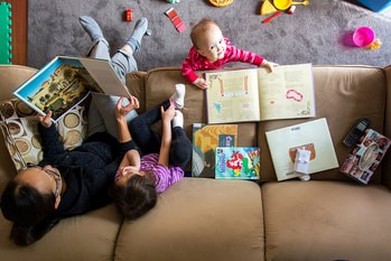
 RSS Feed
RSS Feed
